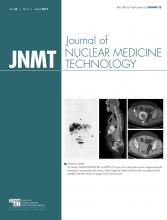TO THE EDITOR: We read with interest the article by Archer and Bolus describing the results of their survey on the use of renal imaging in the United States (1). In the article, they noted that one of the survey questions asked whether the department used “a camera or a blood-based measurement technique.” One of us (Raghuveer K. Halkar) conducted an informal survey of members of the audience at the 2016 Southeast Chapter meeting of the SNMMI by asking them to raise their hands if they used a camera-based technique to measure 99mTc-diethylenetriaminepentaacetate or 99mTc-mercaptoacetyltriglycine clearance. Only about 5% of those in the audience raised their hands; in contrast, 91% of the respondents to the Archer and Bolus survey reported using a camera-based technique.
The explanation for the difference between the 5% and 91% response rates may reside in the wording of the survey question. The phrasing of the question as reported in the article, “a camera or a blood-based measurement,” suggests a question regarding a clearance measurement, but it may have been interpreted as asking whether the software performed a camera-based measurement such as the time to peak height or the half-time. If so, this could explain the difference between the 91% and 5% response rates. Moreover, did respondents only have the option to check camera-based or blood-based measurement or did they have a third option to respond that there was no measurement of clearance? Can the authors comment on this discrepancy and provide the wording of the question on the survey?
Second, the authors listed the most common to least common reasons for a renal scan; it would also be interesting to know the actual percentages associated with each reason. Finally, in our experience, it is urologists who refer patients for suspected obstruction rather than nephrologists; did the questionnaire offer the respondents the option of indicating a urologist as the referring physician?
Footnotes
Published online Feb. 2, 2017.
REFERENCE
- 1.↵







